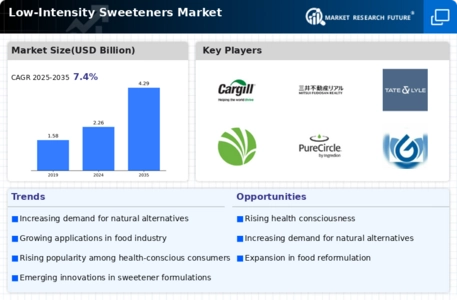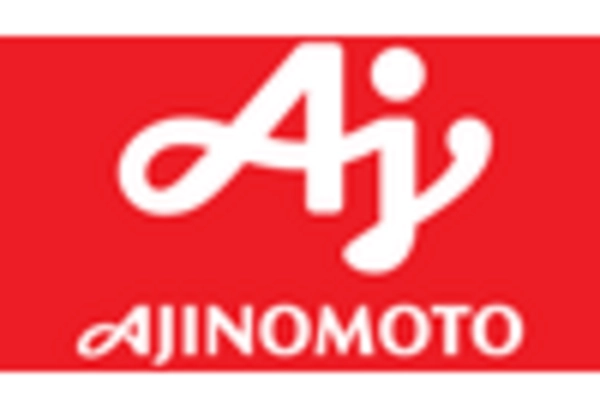Market Trends
Introduction
In the year 2024, the market for low-intensity sweeteners is experiencing a considerable change in the light of several macroeconomic factors. Technological developments in the production and formulation of low-intensity sweeteners have made it possible to produce more refined and versatile products that can be adapted to various consumer preferences. At the same time, regulatory developments in the field of healthy nutrition have influenced product development and labeling, and have forced the market players to quickly adapt. The development of consumers’ habits, with a growing demand for low-calorie and natural alternatives, is also reshaping the market. These developments are of strategic importance for the market players, not only because they affect their position in the competition, but also because they influence their innovation strategies and market entry strategies.
Top Trends
-
Increased Demand for Natural Sweeteners
A growing number of consumers are replacing artificial sweeteners with natural, low-intensity sweeteners, influenced by health concerns. Tate & Lyle, a leader in this field, has added stevia and monk fruit extracts to its range of products. According to a survey, 60% of consumers prefer products with natural sweeteners. This trend is forcing manufacturers to reformulate existing products, with consequences for supply chains and production processes. -
Regulatory Support for Low-Calorie Options
Governments are promoting sugar substitutes as part of their public health campaigns against obesity. In the United States, for example, the Food and Drug Administration has approved a number of new sweeteners and is encouraging their use in food products. These governments’ support is expected to help increase the market penetration of these products as companies make their products comply with public health guidelines. In the future, the trend will probably be towards more stringent labeling requirements to raise consumers’ awareness of the products’ calorie content. -
Technological Advancements in Sweetener Production
The development of biotechnology has greatly increased the efficiency of the production of low intensity sweeteners. In order to produce sweeteners more sustainably, companies like Cargill are investing in fermentation technology. Production costs can be reduced by up to thirty percent, according to studies. Competition on the market will likely increase and prices will fall. -
Rising Popularity of Plant-Based Diets
Plant-based diets are on the rise, and this has led to a rise in demand for low-intensity sweeteners derived from plants. These are now being incorporated into products, notably agave syrup and coconut sugar. Plant-based food sales have increased by 27% in the last year. This trend will lead to further innovation and diversification of the sweetener market. -
Focus on Clean Label Products
Having been prompted by consumers’ demands for clean label products, manufacturers have been compelled to make their ingredients transparent. The demand for products with clean labels has led to the reformulation of products by companies such as Ingredion. Research has shown that 75% of consumers are willing to pay more for clean label products. This trend is expected to have a significant impact on the operational, marketing and sourcing strategies of food manufacturers. -
Expansion of Functional Foods and Beverages
Growth in the consumption of so-called healthy foods and beverages has created new opportunities for low-intensity sweeteners. These sweeteners are being incorporated into products with health benefits such as probiotics. According to market research, the global market for healthy foods and beverages is projected to reach $275 billion by 2025. This trend is likely to lead to closer collaboration between producers of sweeteners and food and beverage manufacturers. -
Sustainability Initiatives in Sweetener Production
A lot of sweetener manufacturers have begun to adopt eco-friendly methods. Roquette Frères is a good example of this. Its production and sourcing are now based on sustainable methods. According to a recent survey, 70 per cent of consumers prefer brands that put the environment first. This trend is expected to have a significant impact on the industry’s investment strategies and operating methods. -
Emergence of New Sweetener Blends
There are also new sweetener mixtures on the market which combine the low-intensity sweeteners with other substances in order to enhance their taste. Leading companies are experimenting with various combinations in order to improve the taste and reduce the aftertaste. These mixtures are supposed to increase acceptance by up to 40%. This trend could lead to new product launches and intensified competition. -
Health Claims and Marketing Strategies
The health claims of low-intensity sweeteners are becoming the main focus of marketing. In particular, the companies are using the concept of weight control and diabetes to attract consumers. These health claims are very successful, with the sale of the product increasing by about 20 percent. This trend will probably lead to the further development of the positioning of the products and more targeted marketing. -
Global Expansion of Sweetener Markets
The market for low-intensity sweeteners is growing worldwide, especially in the emerging economies. The demand for healthier foods is rising in Asia and Africa. The consumption of sweeteners in these countries is growing by 15 per cent annually, according to the latest reports. This trend is expected to lead to greater investment and strategic alliances in these markets.
Conclusion: Navigating the Low-Intensity Sweeteners Landscape
The competition is characterized by considerable fragmentation, with the presence of both established and emerging players. North America and Europe are showing a preference for natural sweeteners, while Asia-Pacific is witnessing a growing demand for new low-calorie products. Strategically, the suppliers are to rely on the development of their capabilities in the areas of artificial intelligence for consumer insights, automation for efficient production and the implementation of sustainable practices to meet regulatory requirements and consumer expectations. The evolution of consumer preferences will also require a certain flexibility in product offerings. The most effective integration of these capabilities will probably lead to the emergence of leaders, which will shape the future of the market.










Leave a Comment